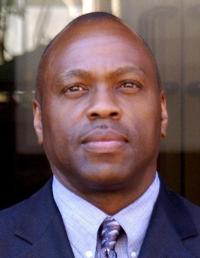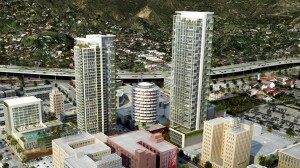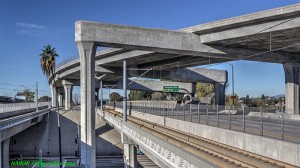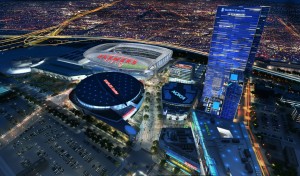Great interview from Gloria Ohland at Move L.A. with Phil Washington, who started his CEO job with LA Metro this week. The hope is that Mr. Washington will help get new transit projects built on time and on- or under-budget. And also that he will bring some innovative financing methods to Los Angeles, as he did in Denver.
On his approach to managing projects (a crucial skill that seems to be sorely lacking in many public agencies):
I try to work always within what planners call the “triple constraints” of schedule, scope and budget because you can’t change one constraint without having an impact on the other two. A transit agencies has to have its act together in order to do a good job of managing the public’s trust — you can’t keep changing the plans because that results in change orders that affect the budget and the schedule. At RTD there were bumps along the road but we always looked at the private sector — the engineering companies and builders — as partners not enemies, and we didn’t sit on problems. I wanted project briefings every couple of weeks, and we valued getting projects done sooner rather than later because that meant that the real estate development would happen sooner and the jobs would be created sooner. Because of these priorities we may not have been as prescriptive as some transit agencies. The transit industry can be closed-minded about relying on the prescribed way of doing things, but I want to be receptive to innovative ideas and new technical concepts.
I was troubled though to read these comments on transit-oriented development:
That’s development in downtown Denver, but we’re also seeing development along both new rail and bus rapid transit lines, proving that development will happen if you just get the transit projects done, which often requires cutting down on the number of change orders and enhancements to lines and stations.
Sadly, transit-oriented development doesn’t just “happen” if you build a transit line, and we need transit leaders like Washington to be well aware of that dynamic in Los Angeles and California more generally. The market opportunities are routinely squelched by neighbors, and in some cases there are no market opportunities at all due to poor siting of rail lines through derelict areas.
On financing, an encouraging and realistic attitude:
We are becoming reluctant financial geniuses in the public sector. Public transportation agencies are always just scraping by, deferring maintenance and new projects, and raising fares. The Highway Trust Fund is just about empty due to declining gas tax revenues — because cars are more fuel-efficient — and projects are only moving forward because Congress transfers money into the Trust Fund from the General Fund. Meantime, the private sector has money sitting on the shelf — from pension funds and private equity — that’s just waiting to be invested somewhere that provides a decent return. Transportation infrastructure is a good investment opportunity when it’s kept in a state of good repair, and it’s an investment opportunity that’s not going away. So if we do it right and negotiate these contracts properly we know there can be benefit for both the public and private sectors because we have complementary needs and assets.
Washington will have his work cut out for him in LA, but he seems to be well-positioned for success. I wish him luck.
He tries to go transit-only on a recent business trip and ran into some trouble:
That afternoon, when I was done at the Hammer, I planned to take the 534 Commuter Express bus to Mark’s office downtown on South Figueroa Street. This, I was told, was a larger and more comfortable vehicle than the standard city buses: more conducive to the business traveler. I checked the sign at the stop: Sure enough, it listed the 534. So I waited. Buses of various colors and shapes came and went. After about 45 minutes, I asked a young woman who was also waiting if she was familiar with the bus. She looked at the sign and giggled. “The 534?” she said. “I’ve never seen that here.”
Dejectedly, I sat on a low stone wall at Wilshire and Westwood and called Mark. “I’ll be there in a little while,” he said. “I told you this wasn’t going to be easy.”
Minutes before he arrived, the 534 pulled in. I just glared at it.
It’s always good to see LA represented in the national media as having a burgeoning rail system and comprehensive bus network, but it’s a bit unfair to buzz in for a weekend with meetings all over the county and expect it to accurately represent the viability of local transit. I’m guessing if you tried to travel a comparable distance in a city like New York, you’d have trouble taking transit there, too.
But then again, maybe that’s the point: the land uses in LA or so spread out, it makes a comprehensive system of county-wide rapid transit infeasible and uneconomical. That’s why the region is better off focusing rapid transit efforts on places where the most people actually live and work. Had this reporter stuck to the primary jobs and housing centers, his trip would have been a lot smoother.
Another argument for ditching the Level of Service-based traffic study under the California Environmental Quality Act (CEQA): a judge yesterday halted a proposed infill apartment tower complex in Hollywood because the proponents failed to adequately study the potential backup the project could cause on the Hollywood Freeway:
The judge cited concerns by Caltrans, which wanted a study of the 101 Freeway on-ramps and off-ramps near the project to address concerns about long lines of cars as a result of the development. The judge said the city’s traffic study did not comply with what Caltrans wanted, “and the city was not free to ignore it.”
The judge also cited Caltrans’ concerns about safety, including long queues of cars on the off-ramps between Vermont and Highland avenues, where vehicles could back up into intersections.
So we can’t get 35- and 39-story apartment buildings right next to a heavy rail subway station because it might inconvenience car drivers on the freeway nearby. I can’t think of a better poster child for why the state should continue its effort to ditch this kind of traffic study in favor of one that deals with the overall impact on driving miles.
Oddly, the pro-infill California Infill Builders Federation is pushing AB 779 to keep this status quo. But under the state’s proposed guidelines per SB 743 (Steinberg, 2013), this kind of analysis wouldn’t even be undertaken in the first place, and we’d have hundreds of housing units in the pipeline above major rail transit.
Somehow I don’t think the developer Millenium will be rushing to join the Infill Builders Federation board anytime soon. But then again, with this group, you never know.
The Los Angeles light rail Green Line, running down the middle of the Century Freeway, is mostly a failure. It runs from a derelict area south of the LAX to an underpass in Norwalk, a few miles short of connecting to Metrolink, with unpleasant stations in the middle of the freeway.
But it was born out of a first-of-its-kind settlement to build the freeway, in an attempt to deliver community benefits. Longreads profiles the federal judge who made it happen, Harry Pregerson:
Like his hero, the late Supreme Court Chief Justice Earl Warren, Pregerson has always had a knack for consensus building. His skill at bringing together divergent parties—Caltrans, neighborhood residents, and unions—and forging a compromise was the key factor in getting the Century Freeway built. According to the L.A. Times, Pregerson was known to open negotiations early in the morning by telling all parties, “Gentlemen, I just happen to have brought my lunch with me and it could be a long day. I’m not sure yet when you’ll be able to eat.”
The Century Freeway’s final consent decree, filed in 1979, included a housing program, jobs program, jobs training program, affirmative-action program, and a child-care program, all under the guise of a freeway project that somehow also had to have a train running down the middle. Even for a legislative body, these initiatives would have been bold, but for them to come at the behest of a district court judge was unheard of.
Pregerson comes off as a bit abrasive and self-centered in the piece (he is a judge after all), but it’s a nice exploration of the long-lasting positive benefits of the settlement.
Ultimately though, as I detail in Railtown, the transit line in the middle of the freeway should have been the far-cheaper bus rapid transit option, which would have been more appropriate for the ridership in that area. But now we’ve got a rail line in the middle of the freeway, with no place to build housing or jobs around it. So while the other community benefits may have worked out well, the Green Line unfortunately did not.
Ryan Reft takes a look at the histories of light rail efforts in both Atlanta and Los Angeles, showing how race, class and local opposition groups limited the effectiveness of both systems:
In both the case of the Blue Line and the construction of MARTA, charismatic, dedicated, and ultimately trusted political leaders fought hard for each and delivered. Could it be that simple, or have the ground rules changed so much that not even a [Los Angeles County supervisor] Kenneth Hahn or [Atlanta mayor] Sam Massell [could] deliver the goods today? In Atlanta at least, a coalition of “planners, hipsters, and other yuppies” haven’t gotten the job done. Perhaps, this time Atlanta should examine how L.A. and Kenneth Hahn managed to constructed a constituency large enough to build the light rail he dreamed of, which brought improvements to Compton and South Central, enabled suburbanites to travel between the region’s two biggest employment centers, and catalyzed award-winning transit-oriented urban development all around the county. In the 1970s, Hahn looked to the Southeast, perhaps Atlanta needs to look to the West.
Both cities suffered the same racial and class divisions that sapped public support for rail and twisted the lines into less effective routes. But I’m struck by the neighborhood opposition to development along the rail lines in both places, particularly based on a fear of gentrification.
In order for light rail to work, in terms of generating sufficient ridership to avoid becoming a huge economic liability for local transit systems, we need the lines to become growth inducing around the stations. That’s really the whole point of a rail line. Yet if we allow neighborhoods to prevent that growth, based on fears of displacement, traffic, lack of parking, and changing the character of the place, then we’ve negated the whole point of rail to begin with.
Certainly the lack of housing affordability and gentrification are reasonable concerns. But they shouldn’t be used as excuses to stop all development. Rather, that development should include a range of affordable housing, and project proponents should do their best to preserve local character.
Otherwise, we’ll end up with more sad rail histories, as we unfortunately see too much of in both Atlanta and Los Angeles.
Los Angeles Mayor Eric Garcetti, board chair of L.A. Metro, announced this morning that Phil Washington, from the Denver Regional Transportation District, will replace former CEO Art Leahy as head of Los Angeles County’s largest transit agency. Washington oversaw a rail building boom in Denver, a city that also launched its rail program via a sales tax measure. In fact, local leaders drew inspiration from Denver’s experience in putting Measure R on the ballot in 2008.
I spoke with Steve Julian at KPCC radio earlier this morning about the new CEO and the challenges he will face:
Some local officials in Los Angeles may be sad that developer AEG is abandoning its dream of a downtown football field. The future Farmers Field was supposed to solidify the emergence of downtown Los Angeles as a destination and boost ridership on game days from the adjacent rail lines.
Public officials were very supportive. State lawmakers gave AEG a pass on environmental review under the California Environmental Quality Act (technically AEG received an accelerated judicial process with agreed-upon, stringent mitigation measures).
From a transit perspective, the news isn’t great. The two other football stadium options in Los Angeles are fairly far out there, with one in Carson and another in Inglewood. These locations are not nearly as centrally located as Farmers Field would have been in terms of rail service and walkability.
But ultimately this may be a bullet dodged for Los Angeles. Football fields are generally a waste of valuable downtown real estate. There are only eight home games a year in the National Football League, and maybe two pre-season games. 10 games out of 365 days? That’s a waste of space for the vast majority of the year.
Sure, the venue can also host soccer games, concerts and maybe some giant outdoor conventions, like if the Pope ever visits. But most of the time it would be idle.
If you’re going to build a sports stadium downtown, it really should be for baseball. You get 81 home games a year with baseball, which means a lot of days and nights with thousands of pedestrians streaming in and out of local shops. Baseball also attracts a more mellow crowd than football, in my experience, so you don’t have the same “drunken brawl” factor (notwithstanding some recent high-profile incidents of baseball fan rage).
Hopefully AEG will find a much better use for that huge parcel downtown. Studies seem to support the idea that more housing, office and retail gives you a better bang for your buck, in terms of economic development and ridership.
In the end, downtown LA will probably come out farther ahead without Farmers Field.
Ryan Reft at KCET penned a relatively brief but comprehensive history of the Blue Line to mark its upcoming 25th anniversary. He acknowledges the ongoing maintenance challenges as well:
The Blue Line’s total cost eventually reached $877 million: $227 million over the 1985 estimate at groundbreaking. Yet its unveiling in 1990 set off a wave of [Pacific Electric] nostalgia. In the ensuing 25 years, it would become the busiest light rail in the nation, ferrying 26 million passengers annually.
That said, in recent years the Blue Line, and light rail in Los Angeles more generally, has encountered some snags: the former, the consequences of neglect; and the latter, community opposition in places like the Exposition Park neighborhood where working class homeowners have expressed worries about gentrification, overburdened public institutions, and crime.
In 2012, $239 million in deferred maintenance resulted in numerous cancellations and delays for the Blue Line. In January and February of 2012 alone, the line experienced 858 delays or cancellations, roughly double the total during the same period in 2011. Most of these issues resulted from aging rail cars, which by 2012 required maintenance after 19,500 miles, down from 26,000 in 2009. Similar issues plagued bus and rail systems nationally. A 2010 report by the Federal Transit Administration argued $77.7 billion would be required to bring all systems to “good repair.”
All the more reason to fund transit operations and find new revenue sources for crumbling infrastructure like the Blue Line (subject of the recent UC Berkeley / UCLA Law report Moving Dollars).
But in the meantime, the article uncovers this bizarre Blue Line promotional video featuring the Teenage Mutant Ninja Turtles:
On Sunday I was interviewed on KCBS News Radio in San Francisco about how California can better spend its transportation dollars. It’s the subject of the new UC Berkeley / UCLA Law report Moving Dollars. I posted the audio, which you can listen to here:
Audio Player
On the heels of the UC Berkeley / UCLA Law report released yesterday, the Sacramento Bee is running on op-ed from me today with recommendations on improving California’s transportation spending:
Potholed roads, crumbling bridges, crowded buses and trains, collisions between cars and bicyclists. In short, California’s transportation infrastructure is in dire need of improvement.
Every year, the state, regional agencies and local governments spend about $28 billion. But are we spending that money effectively?
Too often, decision-makers would rather fund new road and highway projects instead of improving our existing infrastructure and providing more affordable and convenient transportation options. Local political considerations seem to drive these decisions, instead of the most effective use of these funds. And to make matters worse, decision-making is highly decentralized and therefore uncoordinated. Money comes from federal, state and local sources, with multiple levels of government controlling the spending.
Yet these transportation decisions affect our lives as directly as anything our government does. They help determine the layout of our towns and cities, the location of our jobs and shops, and how painlessly we can get where we need to go. The decisions by an agency in a neighboring jurisdiction can mean the difference between an easy commute and a nightmare.
You can read the whole thing here, and also hear me speak about the report at tomorrow’s Planning and Conservation League annual symposium at UC Davis.
Streetsblog LA also posted a nice write-up on the report here. And for those in the Bay Area, I’ll be interviewed about the report on Sunday at 11:20am on KCBS radio.






